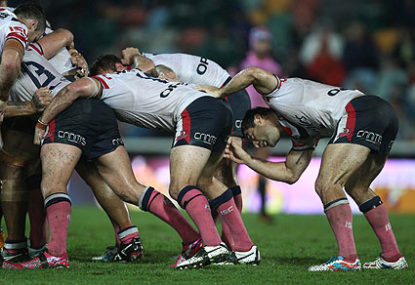The scrum in the NRL has long descended into two adjacent huddles engaged in a stop-work meeting. It is a farce and charade that has become an embarrassment to the code.
Is it salvageable? Do we even care?
The oft proffered 21st century reason for persevering with the scrum – the chance for attacking play because all 12 forwards are confined to the one space – is largely a myth; coaches have backs in the place of forwards in the pack, or a lumbering prop forward as five-eighth. A true backline play from a scrum is a rarity.
I’ve heard it said that rugby league must stick with with the scrum, even in a ramshackle form, as it is a tradition of the game and “we’d hate to see it lost.”
Hello? It’s already long been lost!
What’s left of a true “scrum” is about to collapse to the ground and throw up a roll of dust.
The scrum has become a source of ridicule both within and outside the game. It saddens old fans and puts off potential new fans. It gives rugby unionists a free shot whenever they have the inclination.
The time has come to take scrums seriously or to consign them to history. There is no middle ground.
Even if the packs are made to bind properly, if backs are kept out as backs, no one is going to let the forwards push and fight for possession of the ball are they? No hooker will be allowed to strike for the leather.
If by some freak of circumstance a scrum should ever go against the feed today, almost without fail the referee will blow his whistle and call for the scrum to be reset.
The only way to improve the scrum, to make packs properly bind, to make backs shudder at the thought of taking the place of a forward, to bring about more attacking plays from scrums, is to make the scrum a genuine contest.
Forming scrums for the mere purpose of a charade that nods to the game’s history is the most absurd reason of all for keeping it. The game and the scrum are crying out for reform, innovation, and replacing this present sham of a ritual provides a unique opportunity to enhance the variety of the game.
At the moment rugby league treats the scrum like a heritage protected building that no one is prepared to maintain and renovate – either due to the cost, or out of fear of not knowing what to do. If it hasn’t already, the scrum will soon enough have deteriorated to the point where the only option is demolition.
The scrum in rugby league can be saved, but only by innovation and taking a nod from the past.
The six man pack isn’t sacrosanct to rugby league, nor is the eight to rugby union. Scrums in the late 1880s involved 9-man packs along with a left and right-side half-back.
In 1895 when rugby league began the scrum was eight forwards packed in an arrangement of three in the front row, two in the second, and three in the back.
The 1905 All Blacks used a 7-man scrum with just two players in the front row.
In 1906 the league code was reduced to 13-a-side, with two players from the back row of the scrum made obsolete.
In the 1920s South Sydney, possessing a distinct advantage in forward power and expert scrummagers, routinely played with a 5-man pack and two 5/8ths – it gave the Rabbitohs greater scope in attack and a more formidable defence line.
What rugby league ought to do is put a few days into undertaking trials using different scrum formations, to see if there is an alternative that might work as a relatively trouble-free contest.
I’d be interested in seeing some work-shopping of a scrum using a 2-3-2 (a seven man pack) formation, with the ball placed stationary in the mid-point of the tunnel, and no hooking of the ball allowed – just pushing. The ‘contest’ could begin at the sound of the referee’s whistle.
Don’t like that one? Let’s try a variant. Have the half-back put the ball into the 7-man scrum, but only allow the front-rowers to hook for the ball using their outside leg.
With just two in the front row in lieu of the three-man front row, the ball won’t disappear from view, meaning the referees, the fans, and even the tv cameras, can easily see that the contest for the ball is fairly being fought out.
Having no traditional ‘hooker’ would ensure no return of the scrum penalties and referee interpretations that peppered the game in the late 1970s and finally led to the neutering of the scrum as a contest.
Making the scrum a seven-man contest would also create more space for an attacking play from the scrum.
Such an idea may prove to be a complete crock, but why not spend a few days, a week, whatever, testing out different scrum formations and options?
The best way to keep a heritage building viable and away from the demolition crew is to find a modern use for it. Ironically, the combination of the old and new may yet produce the most pleasing result of all. But we’ll never know if trials are never held and tested.
If such theories fail, and no other compelling variation can be found, then please pack off the rugby league scrum to history, and put it and us out of our misery and torment.





























































































